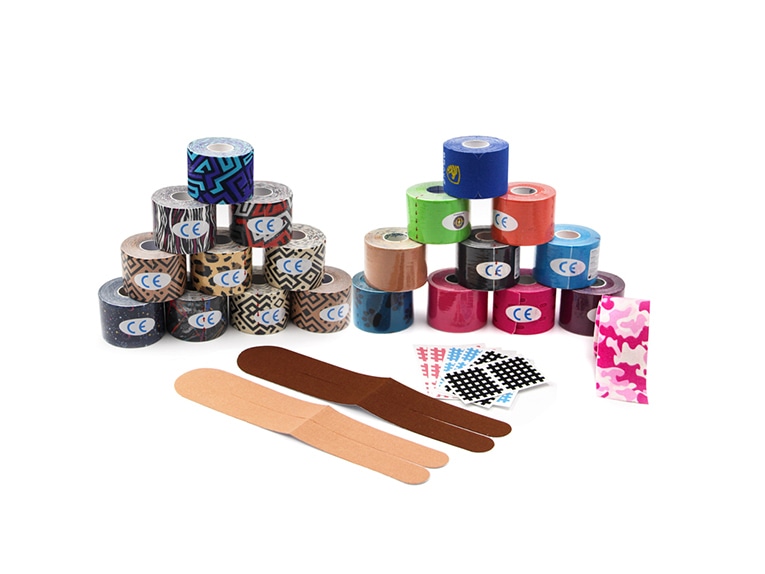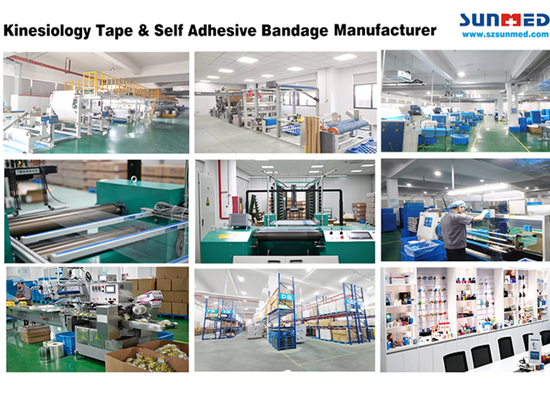
#Industry News
Kinesiology Tape for Knee Support: A Material-Based Mechanism of Action
Why Material Matters in Functional Knee Support
Kinesiology tape is not merely a physical accessory in sports or rehabilitation—it functions as a biomechanical interface between the body and its movement environment. Its effectiveness in knee support arises directly from its material characteristics, specifically its elasticity, adhesive performance, and skin compliance. These attributes enable the tape to deliver non-restrictive joint support, promote circulation, and enhance proprioception.
2. Structural Composition of Kinesiology Tape
Layer Material Functionality
Outer Fabric Rayon or Polyester Provides directional stretch and tensile memory
Adhesive Layer Medical-grade Acrylic Adhesive Heat-activated adhesion, sweat-resistant, latex-free
Liner Silicone-coated Release Paper Maintains adhesive integrity before use
Key Material Properties:
Elasticity: 130–160% stretch capacity mimics human skin
Recoil Memory: Allows passive elastic return after stretch
Breathability: Microporous fabric allows skin ventilation
Adhesive Behavior: Thermo-sensitive and repositionable
3. Material-Driven Mechanisms for Knee Support
a. Elastic Recoil Lifts Skin and Modulates Pressure
Upon application with slight pre-stretch, the tape’s elastic fibers contract, lifting the superficial skin layers and generating interstitial space between the dermis and muscle. This space serves three biomechanical functions:
Reduces local pressure and mechanical irritation
Enhances lymphatic drainage, mitigating swelling and bruising
Stimulates mechanoreceptors (Ruffini endings, Merkel cells) in the skin, improving neuromuscular awareness
This lift is not produced by manual tension, but by the inherent recoil of the fabric once applied.
b. Directional Stretch Guides Movement and Muscle Activation
Kinesiology tape is designed with unidirectional elasticity, which means it stretches primarily along one axis. Depending on the direction and amount of stretch, the tape can:
Encourage activation of specific muscle groups
Resist or guide undesired patellar tracking or joint deviation
Provide subtle biomechanical steering, especially during knee flexion-extension cycles
The material essentially serves as an "external vector," redirecting motion subtly via stored elastic energy.
c. Adhesive Kinetics Support Dynamic Interaction
Unlike rigid tapes, the acrylic adhesive is:
Non-occlusive, allowing moisture and air exchange
Activated by body heat, strengthening adhesion over time
Flexible, moving synchronously with skin and muscle beneath
This allows the tape to remain intact for up to 3–5 days, even under sweat, friction, and multi-directional skin motion—critical for long-term joint applications like knees.
4. Material Behavior Under Clinical and Athletic Conditions
Condition Material Behavior Recommended Application Strategy
Heavy sweating Adhesive softens and strengthens Apply with minimal pre-stretch on anchor ends
High activity (sports) Elasticity maintains tension without slippage Use Y-strips with cross-stabilizing ends
Static rehab Fabric maintains postural tension subtly Apply I-strips medially/laterally across knee cap
5. Comparison: Kinesiology Tape vs. Rigid Support (Material Focus)
Feature Kinesiology Tape Rigid Knee Brace
Base material Rayon/Polyester + acrylic adhesive Neoprene + Velcro / plastic
Elasticity High, skin-mimicking Low to none
Skin conformity High Medium
Adhesion dynamics Thermo-responsive, repositionable Static, friction-dependent
Range of motion impact Preserved full mobility Often reduced
6. Conclusion
The functional efficacy of kinesiology tape in knee rehabilitation and mobility enhancement stems from material science principles rather than mechanical force. Its bi-directional fabric elasticity, dynamic adhesion, and skin-conforming texture make it a bioengineered interface—transforming passive support into active sensorimotor modulation.
In applications ranging from sports injury prevention to post-operative rehab, it is the tape’s material composition—not merely its method of application—that governs its ability to support the knee while preserving freedom of movement.
Sunmed is a manufacturer of kinesiology tape. Our factory is located in Suzhou, China, and has served more than 60 countries. kinesiology tape are supplied to pharmacies, supermarkets, medical distributors, sports brand distributors, etc. Buyers for bulk order are welcome to inquire.




